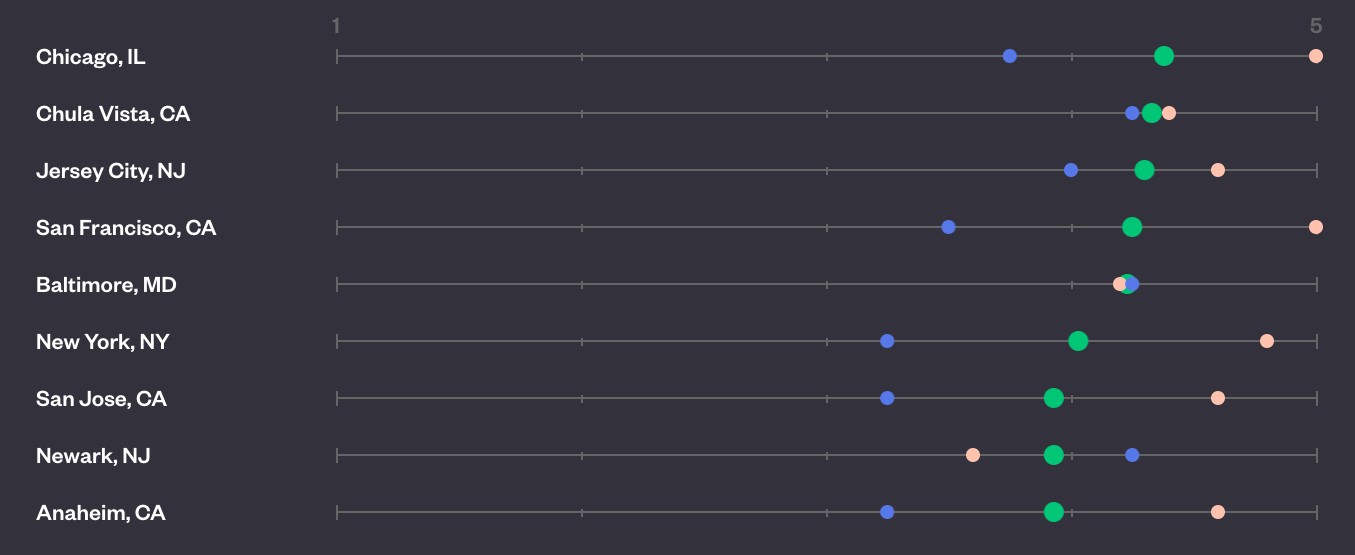Midwestern Cities Take the Lead in Welcoming Immigrants
Date: November 13, 2019

Which city is the best at integrating immigrants into the fabric of American life? This year, according to the NAE Cities Index, it’s the epicenter of the Midwest, Chicago. According to this year’s results, Chicago is an exemplary case when it comes to policies that support immigrants. It is also a place where the socioeconomic divides between its U.S.-born and immigrant residents are relatively small.
The NAE Cities Index, first launched in 2018 as the first-ever comprehensive assessment of cities’ immigration policies and their immigrants’ socioeconomic outcomes, uses 51 unique measures to answer two questions at the heart of the immigration debate: How well are immigrants integrating into American society; and, what role do cities play in that process?
This year’s results also show that Chicago’s success is not unique among Midwestern cities, even though many of them are not traditionally known as immigration hubs. With two years of Index data and scores, we’re now able to identify which cities are moving ahead of the curve in welcoming immigrants. We find that many of cities that improved the most overall are in the Midwest. In fact, among the 10 cities with the largest increases in overall score, four are Midwestern cities: Cleveland, OH, Milwaukee, WI, Toledo, OH, and Chicago, IL—more than any other region in the United States.
Table 1: The Top 10 Cities with the Biggest Increase in Their Overall Scores
| City | Region | Overall Score, 2019 | Overall Score, 2018 |
| Cleveland, OH | Midwest | 3.78 | 2.78 |
| Milwaukee, WI | Midwest | 3.48 | 2.63 |
| Albuquerque, NM | Mountain | 3.48 | 2.63 |
| Oklahoma City, OK | South Central | 3.35 | 2.50 |
| Jersey City, NJ | Northeast | 4.30 | 3.45 |
| Toledo, OH | Midwest | 3.38 | 2.58 |
| Anaheim, CA | Pacific | 3.93 | 3.28 |
| San Antonio, TX | South Central | 3.43 | 2.83 |
| Chicago, IL | Midwest | 4.38 | 3.80 |
| Santa Ana, CA | Pacific | 3.25 | 2.73 |
When we look just at each city’s total policy score, the half of the Index that measures the extent by which each city’s policies support immigrant integration, we find that Toledo, OH, saw the biggest increase in policy score from last year. Toledo went from a policy score of 2.4 to 4 (out of 5) this year. This increase was due in part to having more policies that support immigrant entrepreneurs, expand language access, and allow the acceptance of consular IDs as a form of identification.
In terms of socioeconomic score, the other half of the Index that compares immigrants’ and U.S.-born residents’ socioeconomic outcomes, Cleveland, OH, had the biggest increase. From 2.75 last year, the city improved to 3.75 this year. Not only did median incomes rise and poverty rates fall for all residents in Cleveland, but the city’s immigrant entrepreneurship rate also increased, going from 6.9 percent to 8.0 percent, meaning more new businesses creating more new jobs for all workers.
Do Higher Index Scores Matter?
In general, we find that cities that do well in the Index tend to also have higher levels of well-being for all their residents, regardless of where they were born.
Table 2: Comparing the Top 25 Cities with the Index Cities Overall
| Average of the Top 25 Index Cities | Average of All 100 Index Cities | |
| Median Business Income of U.S.-Born Entrepreneurs | $25,818 | $24,142 |
| Median Business Income of Immigrant Entrepreneurs | $20,952 | $20,740 |
| Share of U.S.-Born Population with A College Degree | 37.6% | 35.2% |
| Share of Immigrant Population with A College Degree | 33.1% | 29.2% |
| Naturalization Rate | 77.4% | 75.8% |
Looking at the top ranked 25 cities compared to the Index average for all cities, we find that the higher scoring cities have better outcomes for both immigrant and U.S.-born entrepreneurs, making them more successful and thus more likely to create and sustain new jobs. For example, U.S.-born entrepreneurs in the top cities are found to earn $1,600 more each year than the Index average. At the same time, foreign-born entrepreneurs in the top 25 cities also earn more—$200 more per year—than the Index average.
The top 25 cities in the Index are also attracting greater shares of high-skilled workers, both U.S.-born and foreign-born, making them more competitive for businesses and investment. In the top 25 cities, the average share of immigrants with a college education (33.1 percent) and U.S.-born people with a college education (37.6 percent) is higher than the Index average (29.2 percent and 35.2 percent, respectively).
Immigrants in the top 25 cities also appear to have a greater sense of belonging. In 2017, about 77.4 percent of the immigrants who were eligible for naturalization had become U.S. citizens in those cities. That’s higher than the average naturalization rate of 75.8 percent for cities in the Index overall.
Policy Trends Among Cities in the Index
The results of this year’s Index also show that cities have increasingly adopted a wide range of policies aimed at welcoming and supporting immigrants (see Table 3) to support prosperous communities. For example, 36 of the 100 cities in the Index now have an office for immigrant affairs, including Chicago’s Office of New Americans. Having such an office is a strong indication of a city government’s leadership and dedication to immigrant integration. Meanwhile, more than half—54 out of 100— of all cities in the Index run or support entrepreneurship programs that cater specifically to immigrants. This includes Madison, Wisconsin’s Kiva Madison project, which provides zero interest loans to immigrant business owners.
Additionally, 11 cities have issued a municipal identification card, such as Detroit ID, to all their residents, making it easier for immigrants to access social services that require identification. And according to data from the Vera Institute of Justice, 24 cities, including Dallas, TX, and Denver, CO, have a legal defense fund available for immigrant residents facing deportation. Lastly, to increase civic engagement, 62 cities have or provided support for services that guide immigrants through the naturalization process.
Table 3: Coverage of Immigration Policies Among the 100 Index Cities
| Number of Index Cities that Have Such a Policy | |
| Establish or maintain a local office for immigrant affairs | 36 |
| Run or provide support for entrepreneurship programs that target immigrants | 54 |
| Issue a municipal ID to all residents, regardless of immigration status | 11 |
| Have legal defense fund available to immigrants facing deportation | 24 |
| Run or provide support for programs that encourage or guide eligible immigrants through the naturalization process | 62 |
Promisingly, several cities have been successful in adopting welcoming policies in the face of strong political headwinds at the state level. Among cities in the states with non-inclusive state immigration policies, Nashville, TN, has the highest policy scores (3.8 out of 5) including 5s for government leadership and community engagement.
Cities Responding to Demographic Change
Cities appear to be responding to demographic shifts by adopting immigration-related policies. Among the 100 cities in the Index, 69 percent experienced an increase the foreign-born share of their total population. The same pattern is even more pronounced in the Midwest, where 82 percent of cities in the Index saw an increase in the foreign-born share of the population. Given that many cities in the Midwest also struggle with declines in the U.S.-born population, many local leaders are thinking proactively about immigrant welcoming and integration policies as a means to stemming population loss and encouraging economic revitalization.
Among cities that have struggled with population loss, some have gone the extra mile to welcome immigrants. This year, we estimated that 18 cities in the Index experienced declines in their U.S.-born population. Among them, 11 cities reported that they had developed or participated in programs intended to attract immigrants. This includes Buffalo, NY, where the U.S.-born population shrank by 0.4 percent. But the arrival of immigrants helped reverse the population decline, resulting in a 0.2 percent increase in the overall population.
Table 4: Demographic Trends Among 100 Index Cities
| Number of Cities | |
| Cities Where Foreign-Born Population Grew | 82 |
| Cities Where Foreign-Born Share of Total Population Increased | 69 |
| Cities Where U.S.-Born Population Declined | 18 |
General Trends
Similar to last year’s results, we found that large, traditional immigration gateways are still ahead of other cities when it comes to immigration policies. Chicago, San Francisco, Los Angeles, and New York got the highest policy scores as a result of their strong set of policies in place to support immigrants. Each city earned perfect scores in at least four out of the five policy categories, and all maintain a local office dedicated to immigrant affairs. However, similar to last year, these cities fared less well on socioeconomic measures such as access to housing or income inequality.
Table 5: Top Cities with the Highest Policy Scores
| City | Policy Score |
| Chicago, IL | 5.0 |
| San Francisco, CA | 5.0 |
| Los Angeles, CA | 4.8 |
| New York, NY | 4.8 |
| Portland, OR | 4.8 |
| Anaheim, CA | 4.6 |
| Denver, CO | 4.6 |
| Jersey City, NJ | 4.6 |
| San Jose, CA | 4.6 |
| Seattle, WA | 4.6 |
Meanwhile, smaller, more affordable cities got the highest socioeconomic scores in the Index. Jacksonville, FL, Norfolk, VA, and St. Petersburg, FL, took the top three spots for socioeconomic outcomes. All three scored especially high in livability, thanks to smaller gaps in homeownership rates, health insurance coverage rates, and educational attainment rates between immigrants and the U.S.-born.
Table 6: Top Cities with the Highest Socioeconomic Scores
| City | Socioeconomic Score |
| Jacksonville, FL | 4.50 |
| Norfolk, VA | 4.50 |
| St. Petersburg, FL | 4.50 |
| Baltimore, MD | 4.25 |
| Chesapeake, VA | 4.25 |
| Chula Vista, CA | 4.25 |
| Greensboro, NC | 4.25 |
| Henderson, NV | 4.25 |
| Newark, NJ | 4.25 |
| Atlanta, GA | 4.00 |
| Fremont, CA | 4.00 |
| Jersey City, NJ | 4.00 |
| New Orleans, LA | 4.00 |
| Virginia Beach, VA | 4.00 |
Overall, the second annual NAE Cities Index shows that cities, especially in the Midwest, are taking the lead in welcoming immigrants. In the cities that fare well in the Index, immigrants are having especially positive impacts on local economies and communities. Immigrants bring much-needed skills and a uniquely entrepreneurial spirit that strengthen Main Streets, create jobs, and expand local tax bases. By placing a spotlight on these cities, the Index effectively highlights their policies as best practices for other community leaders to consider, as they seek ways to help immigrants establish roots and maximize their potentials to the benefit of all.


